古英语和中世纪英语词汇
历史形容词的英语
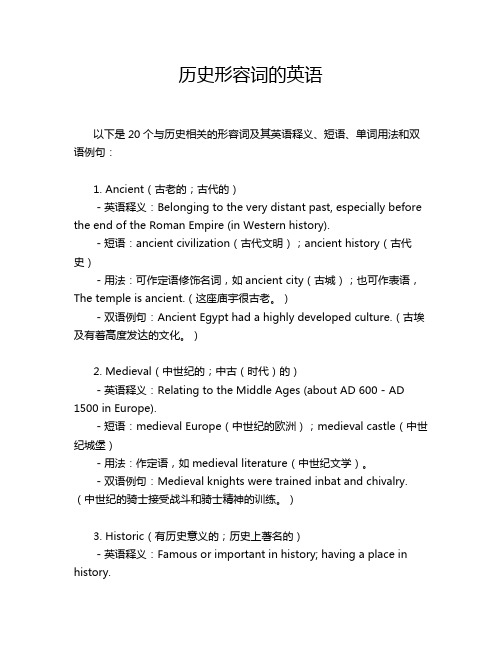
历史形容词的英语以下是20个与历史相关的形容词及其英语释义、短语、单词用法和双语例句:1. Ancient(古老的;古代的)- 英语释义:Belonging to the very distant past, especially before the end of the Roman Empire (in Western history).- 短语:ancient civilization(古代文明);ancient history(古代史)- 用法:可作定语修饰名词,如ancient city(古城);也可作表语,The temple is ancient.(这座庙宇很古老。
)- 双语例句:Ancient Egypt had a highly developed culture.(古埃及有着高度发达的文化。
)2. Medieval(中世纪的;中古(时代)的)- 英语释义:Relating to the Middle Ages (about AD 600 - AD 1500 in Europe).- 短语:medieval Europe(中世纪的欧洲);medieval castle(中世纪城堡)- 用法:作定语,如medieval literature(中世纪文学)。
- 双语例句:Medieval knights were trained inbat and chivalry.(中世纪的骑士接受战斗和骑士精神的训练。
)3. Historic(有历史意义的;历史上著名的)- 英语释义:Famous or important in history; having a place in history.- 短语:historic event(历史性事件);historic site(历史遗址) - 用法:作定语,如a historic building(一座有历史意义的建筑)。
- 双语例句:The signing of the Declaration of Independence was a historic moment.(《独立宣言》的签署是一个历史性的时刻。
历史英语词汇大全掌握历史事件与人物的专业术语

历史英语词汇大全掌握历史事件与人物的专业术语历史英语词汇大全:掌握历史事件与人物的专业术语在学习历史的过程中,了解并掌握相关的专业术语是非常重要的。
不仅可以帮助我们更好地理解历史事件和人物,还可以提升我们的学术素养。
本文将为您提供一个历史英语词汇大全,帮助您掌握历史事件与人物的专业术语。
1. Ancient Civilization (古代文明)- Mesopotamia (美索不达米亚): An ancient civilization located in the Tigris-Euphrates river system, known for its invention of writing, development of urban society, and establishment of the world's earliest known legal code, the Code of Hammurabi.- Ancient Egypt (古埃及): A civilization along the Nile River known for its pyramids, pharaohs, and hieroglyphics. It developed a complex religious and funerary system and made significant contributions to mathematics, architecture, and medicine.2. Classical Antiquity (古典古代)- Ancient Greece (古希腊): The birthplace of democracy, known for its philosophers such as Socrates, Plato, and Aristotle. It made significant contributions to literature, theater, and science. Famous city-states include Athens and Sparta.- Ancient Rome (古罗马): A civilization that expanded from a small village to a vast empire, known for its legal system, engineering marvels like the Colosseum and aqueducts, and influence on European culture.3. Middle Ages (中世纪)- Feudalism (封建制度): A social and economic system based on the exchange of land for military service and loyalty. It characterized much of Europe during the Middle Ages.- Crusades (十字军东征): Series of military expeditions by Christians from Western Europe to reclaim the Holy Land from Muslim control. They lasted from the 11th to the 13th century.4. Renaissance (文艺复兴)- Humanism (人文主义): An intellectual movement that emphasized the study of classical texts, the importance of human potential, and the pursuit of knowledge, art, and science.- Leonardo da Vinci (列奥纳多·达·芬奇): An Italian polymath known for his contributions in the fields of art, science, mathematics, and engineering. Best known for his paintings Mona Lisa and The Last Supper.5. Age of Exploration (探险时代)- Christopher Columbus (克里斯托弗·哥伦布): An Italian explorer who completed four voyages across the Atlantic Ocean, opening the way for widespread European exploration and the eventual colonization of the Americas.- Ferdinand Magellan (费尔南多·麦哲伦): A Portuguese explorer who led the first circumnavigation of the globe. His expedition proved that the Earth was round.6. Industrial Revolution (工业革命)- Steam engine (蒸汽机): Invented by James Watt, the steam engine was a key invention that revolutionized transportation, manufacturing, and agriculture during the Industrial Revolution.- Factory system (工厂体系): A method of manufacturing that brought workers and machinery together in one place, leading to increased efficiency and mass production.7. World Wars (世界大战)- Treaty of Versailles (凡尔赛条约): The peace treaty signed in 1919, officially marking the end of World War I. It placed full blame on Germany and imposed heavy reparations, leading to future political and economic tensions.- D-Day (诺曼底登陆): The Allied invasion of Normandy, France on June 6, 1944, during World War II. It marked a major turning point in the war and led to the eventual defeat of Nazi Germany.通过了解并熟练掌握这些历史英语词汇,我们可以更深入地了解历史的各个时期和相关的事件与人物。
英语词汇发展简史
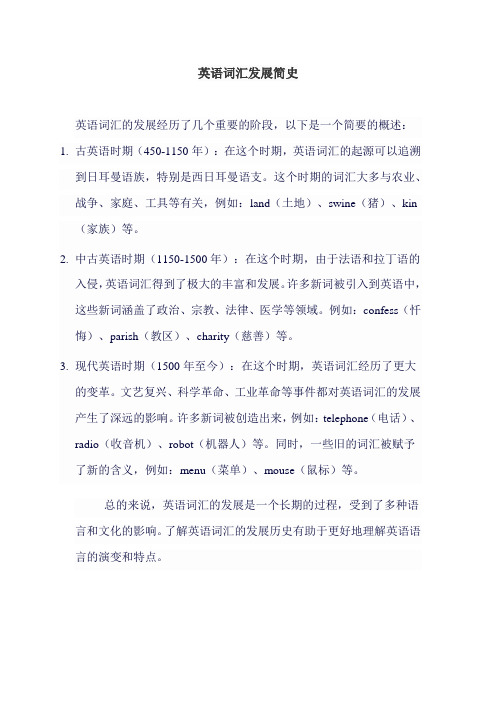
英语词汇发展简史
英语词汇的发展经历了几个重要的阶段,以下是一个简要的概述:1.古英语时期(450-1150年):在这个时期,英语词汇的起源可以追溯
到日耳曼语族,特别是西日耳曼语支。
这个时期的词汇大多与农业、战争、家庭、工具等有关,例如:land(土地)、swine(猪)、kin (家族)等。
2.中古英语时期(1150-1500年):在这个时期,由于法语和拉丁语的
入侵,英语词汇得到了极大的丰富和发展。
许多新词被引入到英语中,这些新词涵盖了政治、宗教、法律、医学等领域。
例如:confess(忏悔)、parish(教区)、charity(慈善)等。
3.现代英语时期(1500年至今):在这个时期,英语词汇经历了更大
的变革。
文艺复兴、科学革命、工业革命等事件都对英语词汇的发展产生了深远的影响。
许多新词被创造出来,例如:telephone(电话)、radio(收音机)、robot(机器人)等。
同时,一些旧的词汇被赋予了新的含义,例如:menu(菜单)、mouse(鼠标)等。
总的来说,英语词汇的发展是一个长期的过程,受到了多种语言和文化的影响。
了解英语词汇的发展历史有助于更好地理解英语语言的演变和特点。
01、古英语文学和中世纪文学
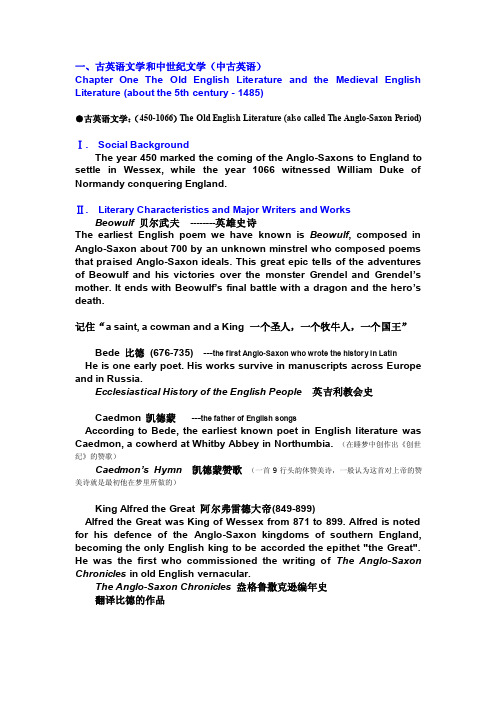
一、古英语文学和中世纪文学(中古英语)Chapter One The Old English Literature and the Medieval English Literature (about the 5th century - 1485)●古英语文学:(450-1066)The Old English Literature (also called The Anglo-Saxon Period)Ⅰ. Social BackgroundThe year 450 marked the coming of the Anglo-Saxons to England to settle in Wessex, while the year 1066 witnessed William Duke of Normandy conquering England.Ⅱ. Literary Characteristics and Major Writers and WorksBeowulf 贝尔武夫--------英雄史诗The earliest English poem we have known is Beowulf, composed in Anglo-Saxon about 700 by an unknown minstrel who composed poems that praised Anglo-Saxon ideals. This great epic tells of the adventures of Beowulf and his victories over the monster Grendel and Grendel’s mother. It ends with Beowulf’s final battle with a dragon and the hero’s death.记住“a saint, a cowman and a King 一个圣人,一个牧牛人,一个国王”Bede 比德(676-735) ---the first Anglo-Saxon who wrote the history in LatinHe is one early poet. His works survive in manuscripts across Europe and in Russia.Ecclesiastical History of the English People 英吉利教会史Caedmon 凯德蒙---the father of English songsAccording to Bede, the earliest known poet in English literature was Caedmon, a cowherd at Whitby Abbey in Northumbia. (在睡梦中创作出《创世纪》的赞歌)Caedmon’s Hymn 凯德蒙赞歌(一首9行头韵体赞美诗,一般认为这首对上帝的赞美诗就是最初他在梦里所做的)King Alfred the Great 阿尔弗雷德大帝(849-899)Alfred the Great was King of Wessex from 871 to 899. Alfred is noted for his defence of the Anglo-Saxon kingdoms of southern England, becoming the only English king to be accorded the epithet "the Great". He was the first who commissioned the writing of The Anglo-Saxon Chronicles in old English vernacular.The Anglo-Saxon Chronicles 盎格鲁撒克逊编年史翻译比德的作品●中世纪文学:(1066-1485)The Medieval English LiteratureⅠ. Social BackgroundMiddle English literature refers to the literature in the period from Norman Conquest to the end of the Wars of the Roses and the accession of Henry Ⅶ. The evolution of something new is most apparent in some of the developments in religious writing in Middle English literature. The literature was various and deeply influenced by French.Ⅱ. Literary Characteristics and Major Writers and WorksTwo main literature forms:Medieval Romance (浪漫传奇:原本指中世纪早期地中海沿岸西部地区的一种用诺曼语讲述的故事。
英语词汇发展史
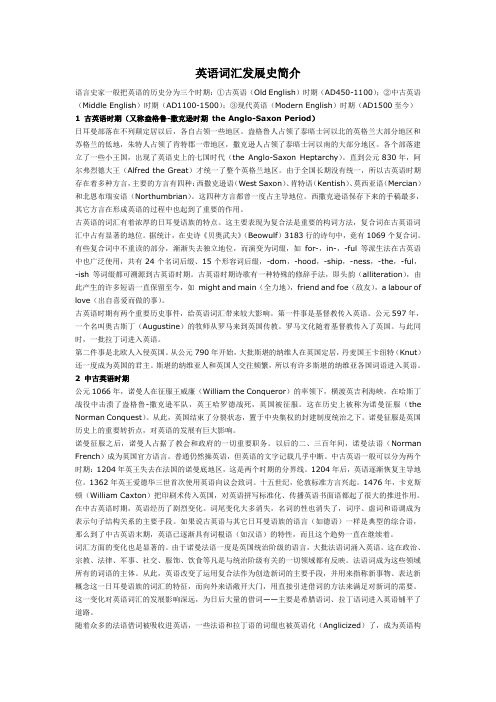
英语词汇发展史简介语言史家一般把英语的历史分为三个时期:①古英语(Old English)时期(AD450-1100);②中古英语(Middle English)时期(AD1100-1500);③现代英语(Modern English)时期(AD1500至今)1 古英语时期(又称盎格鲁-撒克逊时期the Anglo-Saxon Period)日耳曼部落在不列颠定居以后,各自占领一些地区。
盎格鲁人占领了泰晤士河以北的英格兰大部分地区和苏格兰的低地,朱特人占领了肯特郡一带地区,撒克逊人占领了泰晤士河以南的大部分地区。
各个部落建立了一些小王国,出现了英语史上的七国时代(the Anglo-Saxon Heptarchy)。
直到公元830年,阿尔弗烈德大王(Alfred the Great)才统一了整个英格兰地区。
由于全国长期没有统一,所以古英语时期存在着多种方言,主要的方言有四种:西撒克逊语(West Saxon)、肯特语(Kentish)、莫西亚语(Mercian)和北恩布瑞安语(Northumbrian)。
这四种方言都曾一度占主导地位。
西撒克逊语保存下来的手稿最多,其它方言在形成英语的过程中也起到了重要的作用。
古英语的词汇有着浓厚的日耳曼语族的特点。
这主要表现为复合法是重要的构词方法,复合词在古英语词汇中占有显著的地位。
据统计,在史诗《贝奥武夫》(Beowulf)3183行的诗句中,竟有1069个复合词。
有些复合词中不重读的部分,渐渐失去独立地位,而演变为词缀,如for-,in-,-ful等派生法在古英语中也广泛使用,共有24个名词后缀、15个形容词后缀,-dom,-hood,-ship,-ness,-the,-ful,-ish 等词缀都可溯源到古英语时期。
古英语时期诗歌有一种特殊的修辞手法,即头韵(alliteration),由此产生的许多短语一直保留至今,如might and main(全力地),friend and foe(敌友),a labour of love(出自喜爱而做的事)。
中古英语名词

中古英语名词1. Renaissance (文艺复兴): A period of great cultural and artistic change in Europe from the 14th to the 17th century. It saw the revival of interest in classical learning, a growth in scientific exploration, and innovations in art, music, and literature.2. Industrial Revolution (工业革命): A period of major social, economic, and technological change that began in Britain in the late 18th century and spread throughout the world. It saw the development of new manufacturing processes, the growth of cities and factories, and changes in transportation, communication, and agriculture.3. Enlightenment (启蒙运动): A philosophical and intellectual movement in Europe during the 18th century that emphasized reason, individualism, and liberty. It sought to challenge traditional authority and promote scientific inquiry and human progress.4. Romanticism (浪漫主义): An artistic, literary, and intellectual movement that emerged in Europe in the late 18th and early 19th centuries. It emphasized emotion, imagination, and individualism, and celebrated nature, the supernatural, and the exotic.5. Imperialism (帝国主义): A policy or practice of extending a country's power and influence through colonization, use of military force, or economic domination. It was prevalent in the 19th and early 20th centuries as European powers sought to expand their empires and exert control over other regions and peoples.6. Modernism (现代主义): An artistic and literary movement that emerged in the late 19th and early 20th centuries in response to the changing social, cultural, and technological landscape. It emphasized experimentation, abstraction, and the rejection of traditional forms and conventions.7. Civil Rights Movement (公民权利运动): A social and political movement in the United States during the 1950s and 1960s that aimed to end racial discrimination and segregation against African Americans. It was characterized by nonviolent protests, civil disobedience, and legal challenges to unjust laws and practices.8. Feminism (女权主义): A social and political movement that advocates for gender equality and women's rights. It emerged in the 19th century and has continued to evolve and expand in the20th and 21st centuries, promoting issues such as reproductive rights, equal pay, and representation in leadership positions.9. Globalization (全球化): A process of increasing interconnectedness and interdependence among people, businesses, and nations around the world. It has been facilitated by advances in technology, transportation, and communication, and has had both positive and negative effects on economic growth, cultural exchange, and political power dynamics.10. Climate Change (气候变化): A long-term shift in weather patterns and global temperatures caused by the accumulation of greenhouse gases in the atmosphere. It is a significant global challenge that threatens the environment, public health, and theeconomy, and requires collective action at local, national, and international levels to mitigate and adapt to its impacts.。
英语语言发展史
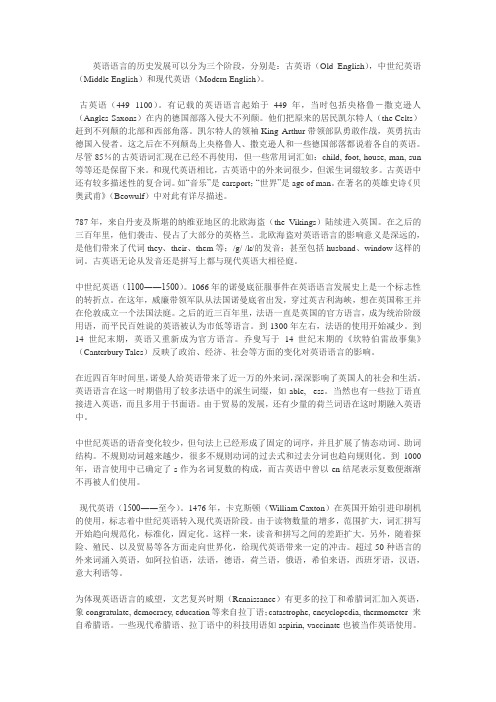
英语语言的历史发展可以分为三个阶段,分别是:古英语(Old English),中世纪英语(Middle English)和现代英语(Modern English)。
古英语(449--1100)。
有记载的英语语言起始于449年,当时包括央格鲁-撒克逊人(Angles-Saxons)在内的德国部落入侵大不列颠。
他们把原来的居民凯尔特人(the Celts)赶到不列颠的北部和西部角落。
凯尔特人的领袖King Arthur带领部队勇敢作战,英勇抗击德国入侵者。
这之后在不列颠岛上央格鲁人、撒克逊人和一些德国部落都说着各自的英语。
尽管85%的古英语词汇现在已经不再使用,但一些常用词汇如:child, foot, house, man, sun 等等还是保留下来。
和现代英语相比,古英语中的外来词很少,但派生词缀较多。
古英语中还有较多描述性的复合词。
如“音乐”是earsport;“世界”是age of man。
在著名的英雄史诗《贝奥武甫》(Beowulf)中对此有详尽描述。
787年,来自丹麦及斯堪的纳维亚地区的北欧海盗(the Vikings)陆续进入英国。
在之后的三百年里,他们袭击、侵占了大部分的英格兰。
北欧海盗对英语语言的影响意义是深远的,是他们带来了代词they、their、them等;/g/ /k/的发音;甚至包括husband、window这样的词。
古英语无论从发音还是拼写上都与现代英语大相径庭。
中世纪英语(1100――1500)。
1066年的诺曼底征服事件在英语语言发展史上是一个标志性的转折点。
在这年,威廉带领军队从法国诺曼底省出发,穿过英吉利海峡,想在英国称王并在伦敦成立一个法国法庭。
之后的近三百年里,法语一直是英国的官方语言,成为统治阶级用语,而平民百姓说的英语被认为市低等语言。
到1300年左右,法语的使用开始减少。
到14世纪末期,英语又重新成为官方语言。
乔叟写于14世纪末期的《坎特伯雷故事集》(Canterbury Tales)反映了政治、经济、社会等方面的变化对英语语言的影响。
古英语和中世纪英语 英国文学考点

第一章古英语时期和中世纪时期的英国文学考点1. The Old English poetry can be divided into two groups: the religious group and the secular one. The Bible consists of the Old Testament and the New Testament. Beowulf 《贝尔武夫》, a typical example of Old English poetry, is regarded as the greatest national epic of the Anglo-Saxons. The epic describes the exploits of a Scandinavian hero, Beowulf, in fighting against the monster Grendel, his revengeful mother, and a fire-breathing dragon in his declining years. While fighting against the dragon, Beowulf was mortally wounded. However, he killed the dragon at the cost of his life. Beowulf is shown not only as a glorious hero but also as a protector of the people.2. Romance is a popular literary form in the medieval England. It sings knightly adventures or other heroic deeds. Chivalry (such as bravery, honor, generosity, and kindness to the weak and poor) is the spirit of romance.3. John Gower is the author of Sir Gawain and the Green Knight, the best romance of the period.William Langland is a more realistic writer who dealt with the religious and social issues of his day in Piers Plowman《农夫皮尔斯》.4. Geoffry Chaucer is the greatest writer of Middle Ages. His masterpiece The Canterbury Tales《坎特伯蕾故事集》presents, for the first time in English literature, a comprehensive realistic picture of the medieval English society and creates a whole gall ery of vivid characters from all walks of life. In “The Canterbury Tales”, Chaucer developed his art of poetry still further towards drama and the art of the novel. In Troilus and Criseyd, he gave the world what is virtually the first modern novel. Chaucer wrote in Middle English and did much in making London dialect the foundation for modern English language. Though essentially still a medieval writer, Chaucer bore marks of humanism and anticipated a new era to come. As a forerunner of humanism, he praises man’s energy, intellect, quick wit and love of life. His tales exposed and satirized the evils of his time. These tales attacked the degeneration of the noble, the heartlessness of the judge, the corruption of the church, etc. In his works, he developed his characterization to a higher level by presenting characters with both typical qualities and individual dispositions. “The Wife of Bath” is a famous tale in which the heroine is depicted as the new bourgeois. Taking the stand of the rising bourgeoisie, he affirms men and opposes the dogma of asceticism preached by the church. Chaucer introduced from France rhymed stanzas of various types into English poetry to replace the Old English alliterative verse. It was he who used for the first time in English the rhymed couplet of iambic pentameter that was later called the “heroic couplet”. The Chaucer’s reputation has been securely established as one of the best English poets for his wisdom, humor, and humanity. John Dryden called Chaucer the father of English poetry.第二章文艺复兴时期的英国文学考点1. Renaissance refers to the transitional period from the medieval to the modern world. It first started in Italy in the 14th century, lasting into the 17th century. The Renaissance means rebirth or revival. It was marked by a humanistic revival of ancient Roman and Greek classics expressed in a flowering of the arts and literature and by the beginnings of modern science. Humanism is the essence of the Renaissance. The English Renaissance did not begin until the reign of Henry VIII. It was usually regarded as England’s Golden Age, especially in literature. Among the literary giants were Shakespeare, Spenser, Johnson, Sidney, Marlowe, Bacon and Donne, and John Milton was the last great poet of the English Renaissance. The real mainstream of the English Renaissance is the Elizabethan drama.2. Humanism is the essence of the Renaissance. It emphasizes the dignity of human beings and the importance of the present life. Humanists voiced their beliefs that man was the center of the universe and man did not only have the right to enjoy the beauty of the present life, but had the ability to perfect himself and to perform wonders.3. Petrarch was regarded as the fountainhead of literature by the English writers. Wyatt introduced the Petrarchan sonnet into England. Surrey brought in blank verse (无韵体诗),i.e. the unrhymed iambic(抑扬格的)pentameter(五音步的)line.4. Renaissance drama: the Elizabethan drama is the real mainstream of the English Renaissance. English dramas were influenced by the Greek and Roman classics. Thomas Kyd wrote the earliest popular tragedy of blood and revenge, The Spanish Tragedy. The most famous dramatists in the Renaissance England are Christopher Marlowe, William Shakespeare, and Ben Johnson. Elizabethan drama reached its peak in Shakespeare’s works. Shakespeare’s compassionate understanding of the human fate has perpetuated his greatness and made him the representative figure of English literature for the whole world. Francis Bacon was the first important English essayist. He was the founder of modern science in England. His writing paved the way for the use of scientific method.5. University Wit refers to any of a notable group of pioneer English dramatists writing during the last 15 years of the 16th century. They transformed the native dramatic inheritance of interlude and chronicle play into a potentially great drama by writing plays of quality and diversity. In doing so they prepared the ground for genius of William Shakespeare. Their forerunner was John Lily, Christopher Marlowe, Thomas Nashe, Robert Green, and Thomas Kyd, etc. All these writers except Thomas Kyd took degrees from universities like Oxford and Cambridge.6. Edmund Spenser: The Shepherd’s Calendar is his early work. Spenser’s masterpiece is the Faerie Queene 《仙后》, a great poem of its age. There are five main qualities in Spenser’s poetry: a perfect melody; a rare sense of beauty; asplendid imagination; a lofty moral purity and seriousness, and a dedicated idealism. It is Spenser’s idealism, his love of beauty, and his exquisite melody that earn him the title of “the poets’ poet.” (诗人的诗人)The Faerie Queene is written in the stanza invented by Spenser himself, the Spenserian stanza, i.e., a stanza(诗的一节)of nine lines, with the first eight lines in iambic pentameter and the last line in iambic hexameter(六音步), rhyming ababbcbcc.7.Christopher Marlowe:(1) As the most gifted of the “University Wits”, Marlowe composed six plays within his short lifetime. Among them the most important are: Tamburlaine, Dr. Faustus, The Jew of Malta and Edward II. Tamburlaine is a play about an ambitious and pitiless Tartar conqueror in the fourteenth century who rose from a shepherd to an overpowering king. By depicting a great hero with high ambition and sheer brutal force in conquering one enemy after another, Morlowe voiced the supreme desire of the man of the Renaissance for infinite power and authority. Dr. Faustus is a play based on the German legend of a magician aspiring for knowledge and finally meeting his tragic end as a result of selling his soul to the Devil. It celebrates the human passion for knowledge, power and happiness; it also reveals man’s frustration in realizing the high aspirations in a hostile moral order. And the confinement to time is the cruelest fact of man’s condition. The play is a good example to illustrate the idea that a man gains the whole world but loses his own soul.(2) Marlowe’s greatest literary achievement lies in that he perfected the blank verse and made it the principal medium of English drama. He brought vitality and grandeur into the blank verse with his “mighty lines” which carry strong emotions. Marlowe’s second achievement is his creation of the Renaissance hero for English drama. Such hero is always individualistic and full of ambition, facing bravely the challenge from both gods and men. Such a hero embodies Marlowe’s humanistic ideal of human dignity and capacity. With the endless aspiration for power, knowledge, and glory, the hero embodies the true Renaissance spirit.8. William Shakespeare (1564—1616):(1) Shakespeare was born on April 23, 1564, into a merchant’s family in Stratford-on-Avon. In 1582, he got married and had three children. It was probably because he had to support his growing family that he left for London. Shakespeare wrote 38 plays, 154 sonnets and 2 long poems. He is the greatest dramatist of the English Renaissance. Shakespeare is above all writers in the past and in the present time. Robert Greene, one of the “University Wits”, resentfully declared him to be “an upstart crow.” He died on April 23, 1616. Shakespeare is surpassingly great because his works never fail to bear a kind of closeness to human life and never fail to be the mirror reflecting human nature. Shakespeare is so great that maybe only Ben Johnson’s praising poem will somewhat cover his greatness: “…Soul of the Age! The applause! delight! The wonder of our stage! Triumph, my Britain, thou hast one toshow To whom all scenes of Europe homage owe. He was not of an age, but for all time!”(2) Shakesp eare’s four dramatic periods:a. His first dramatic period was one of apprenticeship. He wrote five history plays: Henry VI, Parts I, II, and III, Richard III, and Titus Andronicus; and four comedies: The Comedy of Errors, The Two Gentlemen of Verona, The Taming of the Shrew, and Love’s Labour’s Lost.b. His second dramatic period was highly individualized. He wrote five history plays: Richard II, King John, Henry IV, Parts I and II, and Henry V; six comedies: A Midsummer Night’s Dream, The Merchant of Ve nice, Much Ado About Nothing, As You Like It, Twelfth Night, and The Merry Wives of Windsor; and two tragedies: Romeo and Juliet and Julius Caesar. Romeo and Juliet eulogizes the faithfulness of love and the spirit of pursuing happiness. The play, though a tragedy, is permeated with optimistic spirit. Shakespeare’s history plays of these two periods are mainly written under the principle that national unity under a mighty and just sovereign is a necessity.c. His third period includes his greatest tragedies and his so-called dark comedies. The tragedies of this period are: Hamlet, Othello, King Lear, Macbeth, Antony and Cleopatra, Troilus and Cressida, and Coriolanus. The two comedies are: All’s Well That Ends Well and Measure for Measure. Hamlet, Othello, King Lear, and Macbeth are Shakespeare’s four greatest tragedies. They have some characteristics in common. Each tragedy portrays a noble hero, who faces the injustice of human life and is caught in a difficult situation and whose fate is closely connected with the fate of the whole nation. Each hero has his weakness of nature: Hamlet, the melancholic scholar-prince, faces the dilemma between action and mind; Othello’s inner weakness is made use of by the outside evil force; the old King Lear who is unwilling to totally give up his power makes himself suffer from treachery and infidelity. In King Lear, Shakespeare has not only made a profound analysis of the social crisis in which the evils can be seen everywhere, but also criticized the bourgeois egoism; an d Macbeth’s lust for power stirs ups his ambition and leads him to incessant crimes. In these tragedies Shakespeare portrays the weakness of each hero and shows the conflict between the individual and the evil force in the society.d. Shakespeare’s last p eriod includes romantic tragicomedies: Pericles,Cymbeline, The Winter’s Tale, The Tempest, Henry VIII and The Two Noble Kinsmen. The Tempest is the best of his final romances. It typically shows Shakespeare’s pessimistic views towards human life and society in his late years.e. Shakespeare’s non-dramatic poetry consists of two long narrative poems: Venus and Adonis and The Rape of Lucrece,and 154 sonnets. Shakespeare’s sonnets are the only direct expression of the poet’s own feelings. His sonnets numbered 1-126 are addressed to a young man, Shakespea re’s beloved friend. The sonnets numbered 127-152 involve a mistress of Shakespeare, a mysterious “Dark Lady”. His sonnets’ most common themes concern the destructive effects of time, the quickness of physical decay, and the loss of beauty, vigor, and love. Sonnet 18 is one ofShakespeare’s most beautiful sonnets. In the poem he has a profound meditation on the destructive power of time and the eternal beauty brought forth by poetry to the one he loves. A nice summer’s day is usually transient, but the beau ty in poetry can last for ever. Thus Shakespeare has a faith in the permanence of poetry. The rhyme of the poem is abab cdcd efef gg.(3) Shakespeare’s literary ideas:As a humanist writer, Shakespeare has accepted the Renaissance views on literature. He holds that literature should be a combination of beauty, kindness and truth, and should reflect nature and reality. He claims through the mouth of Hamlet that the “end” of dramatic creation is to give faithful reflection of the social realities of the time. He also says that literary works which have truly reflected nature and reality can reach immortality.(4) The Merchant of Venice:The play has a double plot: an impoverished young man, Bassanio asks his friend, Antonio, for a loan so that he might marry Portia, a rich and beautiful heiress of Belmont. They fall in love with each other at first sight. Bassanio passes the test of the caskets and he chooses the right one containing Portia’s portrait. However, their rejoicing is interrupted by a letter fro m Antonio; Antonio’s money is all invested in mercantile expeditions. He has to borrow money from Shylock, the Jewish usurer. Shylock has made a strange bond requiring Antonio to surrender a pound of his flesh if he fails to repay him within a certain peri od of time. Antonio’s letter reads that his ships are lost at sea, and he is penniless, and will have to pay the pound of flesh. The most famous part of the comedy is Act IV, Scene I. It is the major climax of the play. It takes place in a court of law at which Portia appears disguised as a young lawyer instructed to judge the case. She first appeals to Shylock to have mercy. But when he insists on the letter of the law, she lets him have it. He may take his pound of flesh, but there is no mention of blood in the bond; if he sheds a single drop of a Christian’s blood, his lands and goods will be confiscated by the State according to the law of Venice. Thus Antonio is saved, and Shylock has to undergo certain severe penalties, including compulsory conversion to Christianity. The traditional theme of the play is to praise the friendship between Antonio and Bassanio, to idealize Portia as a heroine of great beauty, wit and loyalty, and to expose the Insatiable greed and brutality of the Jew. But people today ten d to regard the play as a satire of the Christian’s hypocrisy and their false standards, their cunning ways of pursuing worldliness and their unreasoning prejudice against Jews.(5) HamletHamlet is considered the greatest of Shakespeare’s tragedies. It has the qualities of a “blood-and-thunder” thriller and a philosophical exploration of life and death. Shakespeare takes the bare outlines of Revenge Tragedy used in Thomas Kyd in his The Spanish Tragedy. The timeless appeal of Hamlet lies in its combination of intrigue, emotional conflict and searching philosophic melancholy. In the play Hamletis urged by the ghost of his father (who is murdered by Claudius) to seek revenge. Hamlet hesitates in his revenge not because he is incapable of action, but because the cast of his mind is so speculative, so questioning, and so contemplative that action, when it finally comes, seems almost like defeat, diminishing rather than adding to the stature of the hero. He lives suspended between fact and fiction, language and action. For Hamlet, soliloquy is a natural medium,a necessary release of his anguish. “To be or not to be” soliloquy is the best known and often felt to be central to Hamlet’s personality. It provides an excellent example of Hamlet not doing anything. In his case we can conclude that too much thinking makes action impossible. The play is also Shakespeare’s most detailed expose of a corrupted court----“an unweeded garden” in which there is nothing but “a foul and pestilent congregation of vapours”(汇集着各种罪恶肮脏的气体).(6) MacbethMacbeth is one of Shakespeare’s four greatest tragedies. He is introduced in the play as a warrior hero, whose fame on the battlefield wins him great honor from the king. His physical courage is joined by a consuming ambition and a tendency to self-doubt----the prediction that he will be king brings him joy, but it also creates inner turmoil. These three attributes----bravery, ambition, and self-doubt----struggle for mastery of Macbeth throughout the play. Shakespeare uses Macbeth to show the terrible effects that ambition and guilt can have on a man who lacks strength of character.(7) King LearLear’s basic flaw at the beginning of the play is that he values appearances above reality. He wants to be treated as a king and to enjoy the title, but he doesn’t want to fulfill a king’s o bligations of governing for the good of his subjects. Similarly, his test of his daughters demonstrates that he values a flattering public display of love over real love. But his values do change over the course of the play. As he realizes his weakness and insignificance in comparison to the awesome forces of the natural world, he becomes a humble and caring individual. Eventually, Lear displays regret, remorse, empathy, and compassion for the poor, a population that Lear has not noticed before. He comes to cherish Cordelia above everything else and to place his own love for Cordelia above every other consideration, to the point that he would rather live in prison with her than rule as a king again. King Lear’s madness: The madness in King Lear enables him to realize the essence of a corrupt society, in which each is ready to destroy the other. He not only sympathizes with the poor but realizes for the first time with much remorse for his former tyranny and indifference toward the suffering multitude. The mad ness is also the course of Lear’s spiritual pilgrimage from arrogance into humiliation, misery, and finally a rebirth into a childlike simplicity and humility. Moreover, King Lear also presents Shakespeare’s affirmation of national unity and royal responsibility. Shakespeare seems to point out that the king, however great he might be, should be responsible to the people. If, in one way or another, he betrays the people’s trust, history will condemn him. It is just at this point, when heseems to have earned an innocent happiness, that his tragic suffering culminates, since Cordelia meets her death in the very hour of victory.9. Francis BaconFrancis Bacon, a representative of the Renaissance in England, is a well-known philosopher, scientist and essayist. He lays the foundation for modern science with his insistence on scientific way of thinking and fresh observation rather than authority as a basis for obtaining knowledge. His Essays is the first example of that genre in English literature. Bacon borro wed the term “essay” from Montaigne, the first great modern essayist, the predecessor of Bacon. The Advancement of Learning is a great tract on education. Here Bacon highly praises knowledge, refuting the objections to learning and outlining the problems with which his plan is to deal. Also he answers the charge that learning is against religion. Novum Organum (The New Instrument) is a successful treatise written in Latin on methodology. The argument is for the use of inductive method of reasoning (归纳推理的方法) in scientific study. Of Studies is the most popular of Bacon’s essays. It analyzes what studies chiefly serve for, the different ways adopted by different people to pursue studies, and how studies exert influence over human character. Forceful and persuasive, compact and precise, the essay reveals to us Bacon’s mature attitude towards learning. Famous quotations from Bacon: Studies serve for delight, for ornament and for ability. Reading makes a full man, conference a ready man, and writing an exact man.10. Metaphysical Poetry(玄学派诗歌)The term “metaphysical poetry” is commonly used to name the work of the 17th-century writers who wrote under the influence of John Donne. With a rebellious spirit, the metaphysical poets tried to break away from the conventional fashion of the Elizabethan love poetry. The diction is simple as compared with that of the Elizabethan or the Neoclassical periods, and echoes the words and cadences of common speech. The imagery is drawn from actual life. The form is frequently that of an argument with the poet’s beloved, with God, or with himself. Modern poets like T. S. Eliot, John Ransom, and Allen Tate are examples who have been mostly affected by the metaphysical influence. 11. metaphysical conceit: The metaphysical conceit, associated with the Metaphysical poets of the 17th century, is a more intricate and intellectual device. It sets up an analogy, usually between one entity’s spiritual qualities and an object in the physical world, that sometimes controls the whole structure of the poem. For example, in John Donne’s A Valediction: Forbidding Mourning, two lovers’ souls are compared to a draftsman’s compass.11. John DonneJohn Donne is the leading figure of the “metaphysical school”. The most striking feature of Donne’s poetry is precisely its tang of reality, in the sense that it seems to reflect life in a real rather than a poetical world. John Donne is a religious poet. His great prose works are his sermons. It is the obsession with death that characterizesDonne’s mature re ligious works. The Songs and Sonnets is probably his best-known lyrics. Love is the basic theme. Donne holds that the nature of love is the union of soul and body. In his poetry, Donne frequently applies conceits(奇想/夸张的比喻), i.e. extended metaphors involving dramatic contrasts. His poem, The Sun Rising, is taken from his Songs and Sonnets. The speaker in the poem is showing his annoyance at the sun entering the lover’s secret room without their approval. Also he me ans that lover’s schedule needn’t follow the sun’s movement. His poem, Death, Be Not Proud, is taken from his Holy Sonnets. The poem means that shortly after we die we will wake up (as from sleep) and live eternally. It reveals the poet’s belief in life af ter death: death is but momentary while happiness after death is eternal.12. John MiltonJohn Milton is a versatile writer. He wrote sonnets, elegies, long narrative poems, short lyrics, and prose works. His literary ambition of his youth was to write an epic which England would “not willingly let die.” As a real revolutionary, a master poet and a great prose writer, Milton holds an important place in the history of English literature. His literary achievements can be divided into three groups: the early poetic works, the middle prose pamphlets and the last great poems. In his early works, Milton appears as the inheritor of all that was best in Elizabethan literature. Lycidas, an elegy dedicated to a drowned friend, is a typical example. His powerful pamphlets in his middle period make him the greatest prose writer of his age. Areopagitica 《论出版自由》is probably his most memorable prose work. It is a great plea for freedom of the press. But, Milton’s highest achievements were made in the final period of his writing career. In the last period, he wrote three major poetic works: Paradise Lost, Paradise Regained and Samson Agonistes. Among the three, the first is the greatest, indeed the only generally acknowledged epic in English literature since Beowulf; and the last one is the most perfect example of the verse drama after the Greek style in English. Paradise Regained, a long narrative poem, tells how man, in the person of Christ, withstands the tempter and is established once more in the divine favor. In Samson Agonistes, a verse drama modeled on the Greek tragedy, Milton presents to us a picture of how Samson, the Israel’s mighty champion, brings destruction down upon the enemy at the cost of his own life. The whole poem strongly suggests Milton’s passionate longing like Samson’s that he too could bring destruction down upon the enemy at the cost of his own life. In this sense, Samson is Milton. Paradise Lost Paradise Lost, the only generally acknowledged epic in English since Beowulf, is Milton’s highest achieve ment (his masterpiece). The story is taken from the Bible. The theme of the epic is the “Fall of Man,” i. e. man’s disobedience and the loss of Paradise, with its prime cause ---- Satan. It intends to expose the ways of Satan and to “justify the ways of God to men.” In Heaven, Satan led a rebellion against God. Defeated, he and his angels were cast into Hell. However, Satan refused to accept his failure, vowing that “all was not lost” and that he would seek revenge for his downfall. In order to achieve his ambition, Satan, in the shape of a snake, managed to tempt Adam and Eve, the first human beings created by God, to eat fruit from the tree of knowledge against God’s instruction. For their disobedience, Adam and Eve weredriven out of Paradise. Satan is the real hero of the poem. Satan, in the image of a rebel, remains obeyed and admired by those who follow him down to hell. The features of his character include his boldness, unbending ambition and “unconquerable will”. The poem is full of biblical and clas sical allusions. The majesty of expression suits well the sublimity of the poet’s thought. John Milton’s style reminds one of Roman poet Virgil.第三章新古典主义时期的英国文学1. The Enlightenment Movement(启蒙主义运动)The eighteenth-century England is known as the Age of Enlightenment or the Age of Reason. The Enlightenment Movement was a progressive intellectual movement which flourished in France and swept through Western Europe at the time. The movement was a furtherance of the 15th and 16th centuries. Its purpose was to enlighten the whole world with the light of modern philosophical and artistic ideas. The enlighteners celebrated reason or rationality, equality and science. They called for a reference to order, reason and rules and advocated universal education. Famous among the great enlighteners in England were those great writers like John Dryden (约翰﹒德莱顿), Alexander Pope(亚历山大﹒蒲柏), Joseph Addison(约瑟夫﹒艾迪森)and Sir Richard Steele(理查﹒斯蒂尔), the two pioneers of familiar essays(随笔散文), Jonathan Swift(乔纳森﹒斯威夫特),Richard Bringsley Sheridan(谢拉丹), Daniel Defoe(丹尼尔﹒笛福), Henry Fielding(亨利﹒菲尔丁)and Samuel Johnson(塞缪尔﹒约翰逊).2. Neoclassicism(新古典主义)In the field of literature, the Enlightenment Movement brought about a revival of interest in the old classical works. This tendency is known as neoclassicism. According to the neoclassicists(新古典主义者), all forms of literature were to be modeled after the classical works of the ancient Greek and Roman writers (Homer, Virgil(维吉尔), and so on.) and those of the contemporary French ones. They believed that the artistic ideals should be order, logic, restrained emotion and accuracy, and that literature should be judged in terms of its service to humanity. This belief led them to seek proportion(协调性), unity(统一性), harmony(和谐性)and grace (典雅性)in literary expressions, in an effort to delight, instruct and correct human beings, primarily as social animals. Thus, a polite, urbane,witty, and intellectual art developed. The middle part of the 18th century was predominated by a newly rising literary form---the modern English novel, which gives a realistic presentation of life of the common English people. This is the most significant phenomenon in the history of the development of English literature.3. The Graveyard School (墓地派诗歌)It refers to a school of poets of the 18th century whose poems are mostly devoted to a sentimental lamentation or meditation on life, past and present, with death and graveyard as themes. Thomas Gray(托马斯﹒格雷)is considered to be the leading figure of this school and his “Elegy Written in a Country Churchyard”《写在乡村教堂墓地的挽歌》is its most representative work. In this poem, Gray reflects on death, the sorrows of life, and the mysteries of human life with a touch of his personal melancholy. The poet compares the common folk with the great ones, wondering what the commons could have achieved if they had had the chance. Here he reveals his sympathy for the poor and the unknown, but mocks the great ones who despise the poor and bring havoc on them.4. The Heroic Couplet(英雄体偶句)It means a pair of lines of a type once common in English poetry, in other words, it means iambic pentameter rhymed in two lines.5. Gothic Novel(哥特式小说)It is a school of novel that appeared in the 18th century. Such a novel is often of mystery and horror which takes place in some haunted or dilapidated Middle Ages castles.6. John BunyanBunyan is a religious novelist whose style was modeled after that of the English Bible. His concrete and living language and vivid details made it possible for the reader of the least education to share the pleasure of reading his novel and to relive the experience of his character. His masterpiece, The Pilgrim’s Progress《天涯历程》, is the most successful religious allegory, tells of the experience of a devout Christian the Pilgrim with a neighbor named Faithful in a world full of vice and wickedness. Through the Christian the Pilgrim’s allegorical journey from the doomed city to the Celestial City, Bunyan means to urge people to comply with Christian doctrines and seek salvation through constant struggles with their own weaknesses and all kinds of social evils. The novel is not only about something spiritual but also bears much relevance to the time. Its predominant metaphor ---life as a journey--- is simple and familiar. The Vanity Fair is a famous scene where all such merchandise sold, as houses, lands, trades, places, honors, titles, countries, kingdom, lusts, pleasures, wives, husbands, children, blood, bodies, souls, gold, pearls…, etc. except one thing---truth.A wise saying goes, “All that cometh is vanity.”7. Alexander PopeAs a representative of the Enlightenment, Pope was one of the first to introduce rationalism to England. He was the greatest poet of the Neoclassical period. He。
英国文学名词解释大全(整理版)
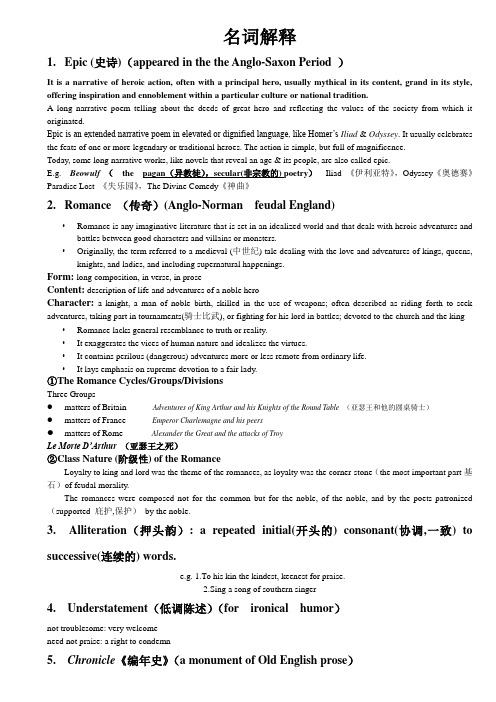
名词解释1.Epic(史诗)(appeared in the the Anglo-Saxon Period )It is a narrative of heroic action, often with a principal hero, usually mythical in its content, grand in its style, offering inspiration and ennoblement within a particular culture or national tradition.A long narrative poem telling about the deeds of great hero and reflecting the values of the society from which it originated.Epic is an extended narrative poem in elevated or dignified language, like Homer’s Iliad & Odyssey. It usually celebrates the feats of one or more legendary or traditional heroes. The action is simple, but full of magnificence.Today, some long narrative works, like novels that reveal an age & its people, are also called epic.E.g. Beowulf (the pagan(异教徒),secular(非宗教的) poetry)Iliad 《伊利亚特》,Odyssey《奥德赛》Paradise Lost 《失乐园》,The Divine Comedy《神曲》2.Romance (传奇)(Anglo-Norman feudal England)•Romance is any imaginative literature that is set in an idealized world and that deals with heroic adventures and battles between good characters and villains or monsters.•Originally, the term referred to a medieval (中世纪) tale dealing with the love and adventures of kings, queens, knights, and ladies, and including supernatural happenings.Form:long composition, in verse, in proseContent:description of life and adventures of a noble heroCharacter:a knight, a man of noble birth, skilled in the use of weapons; often described as riding forth to seek adventures, taking part in tournaments(骑士比武), or fighting for his lord in battles; devoted to the church and the king •Romance lacks general resemblance to truth or reality.•It exaggerates the vices of human nature and idealizes the virtues.•It contains perilous (dangerous) adventures more or less remote from ordinary life.•It lays emphasis on supreme devotion to a fair lady.①The Romance Cycles/Groups/DivisionsThree Groups●matters of Britain Adventures of King Arthur and his Knights of the Round Table (亚瑟王和他的圆桌骑士)●matters of France Emperor Charlemagne and his peers●matters of Rome Alexander the Great and the attacks of TroyLe Morte D’Arthur (亚瑟王之死)②Class Nature (阶级性) of the RomanceLoyalty to king and lord was the theme of the romances, as loyalty was the corner-stone(the most important part基石)of feudal morality.The romances were composed not for the common but for the noble, of the noble, and by the poets patronized (supported 庇护,保护)by the noble.3. Alliteration(押头韵): a repeated initial(开头的) consonant(协调,一致) to successive(连续的) words.e.g. 1.To his kin the kindest, keenest for praise.2.Sing a song of southern singer4. Understatement(低调陈述)(for ironical humor)not troublesome: very welcomeneed not praise: a right to condemn5. Chronicle《编年史》(a monument of Old English prose)6. Ballads (民谣)(The most important department of English folk literature )①Definition:A ballad is a narrative poem that tells a story, and is usually meant to be sung or recited in musical form.An important stream of the Medieval folk literature②Features of English Ballads1. The ballads are in various English and Scottish dialects.2. They were created collectively and revised when handed down from mouth to mouth.3. They are mainly the literature of the peasants, and give an outlook of the English common people in feudal society.③Stylistic (风格上)Features of the Ballads1. Composed in couplets (相连并押韵的两行诗,对句)or in quatrains (四行诗)known as the ballad stanza (民谣诗节), rhyming abab or abcb, with the first and third lines carrying 4 accented syllables (重读音节)and the second and fourth carrying 3.2. Simple, plain language or dialect (方言,土语)of the common people with colloquial (口语的,会话的), vivid and, sometimes, idiomatic (符合当地语言习惯的)expressions3. Telling a good story with a vivid presentation around the central plot.4. Using a high proportion of dialogue with a romantic or tragic dimension (方面)to achieve dramatic effect.④Subjects of English Ballads1. struggle of young lovers2. conflict between love and wealth3. cruelty of jealousy4. criticism of the civil war5. matters of class struggle7. Heroic couplet (英雄双韵体)(introduced by Geoffrey Chaucer)Definition:the rhymed couplet of iambic pentameter; a verse form in epic poetry, with lines of ten syllables and five stresses, in rhyming pairs.英雄诗体/英雄双韵体:用于史诗或叙事诗,每行十个音节,五个音部,每两行押韵。
雅思备考之历史类词汇汇总

雅思备考之历史类词汇汇总1.Ancient Civilization: 古代文明2.Bronze Age: 青铜时代3.Iron Age: 铁器时代4.Classical Age: 古典时代5.Dark Ages: 黑暗时代6.Renaissance: 文艺复兴7.Middle Ages: 中世纪8.Age of Discovery: 发现时代9.Industrial Revolution: 工业革命10.World War I: 第一次世界大战11.World War II: 第二次世界大战12.Cold War: 冷战13.Post-Cold War Era: 冷战后时代14.Neolithic Age: 新石器时代15.Minoan Civilization: 米诺斯文明16.Mycenaean Civilization: 迈锡尼文明17.Hellenistic Age: 希腊化时代18.Byzantine Empire: 拜占庭帝国19.Medieval Times: 中世纪时期20.Ottoman Empire: 奥斯曼帝国21.Han Dynasty: 汉朝22.Tang Dynasty: 唐朝23.Song Dynasty: 宋朝24.Ming Dynasty: 明朝25.Qing Dynasty: 清朝26.Ming Fleet: 郑和下西洋的船队27.Age of Exploration: 探险时代28.Discovery of Americas: 美洲的发现29.Age of Enlightenment: 启蒙时代30.French Revolution: 法国大革命31.Industrial Revolution in Britain英国工业革命32. Meiji Restoration:明治维新33. World War II:二战34. Cold War:冷战35. End of Cold War:冷战结束36. Middle Ages:中世纪37. Renaissance:文艺复兴38. Ancient Greece:古希腊39. Ancient Rome:古罗马40. Byzantine Empire:拜占庭帝国41. Ottoman Empire:奥斯曼帝国42. Napoleon Bonaparte:拿破仑43. Adolf Hitler:希特勒44. Franklin D. Roosevelt: 罗斯福45. Winston Churchill:丘吉尔。
(完整版)英语词汇起源(200词)

英语词汇起源(200词)1、Chemistry 化学古代的炼金术士们总想找到一种方法,将低贱的金属变为金子。
现在通过原子裂变的原理表明,他们的这种想法并非一般人们想象的那么愚蠢。
古埃及人入侵欧洲后,将他们所研究的炼金术,连同其命名al-kimia一起传入欧洲。
后来,这个词变成alchemy,“炼金的人”叫做alchemist,最后成了chemistry。
“化学”的概念就是从“炼金术”演变来的。
2、Geology 地质学“地质学”是研究形成地球的物质和地壳构造,以探讨地球的形成和发展的科学。
Geology是从希腊语来的,ge即“earth”;-ology,“science”,即研究地球本身的科学。
3、Law 法律“法律”是立法机关制定的、国家政权保证执行的行为规则。
Law在古英语中写作lagu,意即“something laid down (规定下来的事情)”。
4、Electricity 电古希腊人常用琥珀制作爱情护符,确信戴着这种护符的人可以引来爱人。
他们发现,磨擦琥珀可以吸引羽毛、线头等小东西,磨擦时会放出火花。
他们就把这种磨擦起电的现象叫做elektron。
来自希腊语elektor,意即“发光的太阳”,进入拉丁语后写作electrum。
英语演变为electricity。
5、Atom 原子古希腊人认为,特质是不可能无限止地分割下去的,越分越小,最后小到不可再分。
他们把“原子”叫做atomos:a即“not”;tomos ,“cut”意即“不能再分割”以后这个词在英语中演变为atom。
尽管后来发现“原子”并非“不可再分割”,然而约定俗成,“原子”的名字仍然以atom流传下来。
6、Uranium 铀“铀”是一种放射性金属元素,化学符号为U,主要用来产生原子能。
著名的物理学家居里夫人曾用铀作实验,发现了放射现象。
Uranium这个词是从希腊神话中一位神的名字来的。
1781年,英籍德国天文学家赫瑟尔(Sir William Herschel)发现了颗尚未被人们发现的行星,于是他就借用了希腊神话中“天王”Ouranos的名字,命名这颗行星为Uranus。
英语课程中的历史文化专题词汇
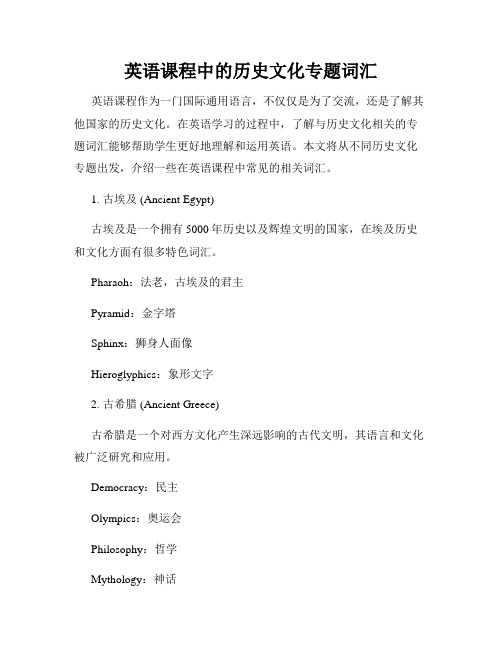
英语课程中的历史文化专题词汇英语课程作为一门国际通用语言,不仅仅是为了交流,还是了解其他国家的历史文化。
在英语学习的过程中,了解与历史文化相关的专题词汇能够帮助学生更好地理解和运用英语。
本文将从不同历史文化专题出发,介绍一些在英语课程中常见的相关词汇。
1. 古埃及 (Ancient Egypt)古埃及是一个拥有5000年历史以及辉煌文明的国家,在埃及历史和文化方面有很多特色词汇。
Pharaoh:法老,古埃及的君主Pyramid:金字塔Sphinx:狮身人面像Hieroglyphics:象形文字2. 古希腊 (Ancient Greece)古希腊是一个对西方文化产生深远影响的古代文明,其语言和文化被广泛研究和应用。
Democracy:民主Olympics:奥运会Philosophy:哲学Mythology:神话3. 古罗马 (Ancient Rome)古罗马是欧洲历史上最伟大的文明之一,其政治、法律、建筑和文化对世界产生了广泛的影响。
Colosseum:斗兽场Aqueduct:古罗马引水工程Gladiator:角斗士Roman Empire:罗马帝国4. 世界文明 (World Civilizations)世界各地的文明和历史都对英语课程中的专题词汇有所贡献。
Great Wall of China:长城Samurai:日本武士Maya Civilization:玛雅文明Hinduism:印度教5. 中世纪 (Medieval Times)中世纪是欧洲历史中一个重要的时期,影响着政治、文化和社会。
Knighthood:骑士精神Feudalism:封建主义Cathedral:大教堂Plague:黑死病6. 文艺复兴 (Renaissance)文艺复兴是欧洲历史上的一次重大变革,对文学、艺术和科学产生了深远影响。
Leonardo da Vinci:达芬奇Michelangelo:米开朗琪罗Humanism:人文主义Reformation:宗教改革总结:在英语课程中学习历史文化专题词汇,不仅拓宽了学生的知识面,还能增进对不同文化的理解和尊重。
所有学科历史单词

所有学科历史单词1. 历史(lì shǐ) - history2. 学科(xué kē) - subject3. 文化 (wén huà) - culture4. 社会 (shè huì) - society5. 政治 (zhèng zhì) - politics6. 宗教(zōng jiào) - religion7. 经济(jīng jì) - economy8. 科技(kē jì) - science and technology9. 文明 (wén míng) - civilization10. 战争(zhàn zhēng) - war11. 农业 (nóng yè) - agriculture12. 工业(gōng yè) - industry13. 帝国 (dì guó) - empire14. 古代(gǔ dài) - ancient15. 现代 (xiàn dài) - modern16. 中世纪(zhōng shì jì) - Middle Ages17. 文艺复兴(wén yì fù xīng) - Renaissance18. 启蒙运动(qǐ méng yùn dòng) - Enlightenment19. 革命 (gé mìng) - revolution20. 自由 (zì yóu) - freedom21. 思想家(sī xiǎng jiā) - thinker22. 统治者(tǒng zhì zhě) - ruler23. 民主(mín zhǔ) - democracy24. (dú cái) - dictatorship25. 君主(jūn zhǔ) - monarch26. 民族 (mín zú) - ethnic group27. 市民 (shì mín) - citizen28. 战胜 (zhàn shèng) - conquer29. 钢铁(gāng tiě) - steel30. 进步 (jìn bù) - progress31. 原始人(yuán shǐ rén) - primitive man32. 社会科学(shè huì kē xué) - social sciences33. 历史学家(lì shǐ xué jiā) - historian34. 史书(shǐ shū) - historical book35. 文化遗产(wén huà yí chǎn) - cultural heritage36. 历史事件(lì shǐ shì jiàn) - historical event37. 历史发展(lì shǐ fā zhǎn) - historical development38. 重要人物 (zhòng yào rén wù) - important figure39. 古迹(gǔ jì) - historical site40. 遗址(yí zhǐ) - ruins41. 解放(jiě fàng) - liberation42. 冷战(lěng zhàn) - Cold War43. 帝国主义(dì guó zhǔ yì) - imperialism44. 文化革命 (wén huà gé mìng) - Cultural Revolution45. 正义 (zhèng yì) - justice46. 平等(píng děng) - equality47. 科学家(kē xué jiā) - scientist48. 历史资料(lì shǐ zī liào) - historical data49. 纪录片 (jì lù piàn) - documentary50. 研究(yán jiū) - research51. 民俗 (mín sú) - folklore52. 个人自由 (gè rén zì yóu) - individual freedom53. 战略 (zhàn lüè) - strategy54. 群众运动 (qún zhòng yùn dòng) - mass movement55. 政府(zhèng fǔ) - government56. 国家(guó jiā) - nation57. 政策 (zhèng cè) - policy58. 科学发现(kē xué fā xiàn) - scientific discovery59. 历史遗迹(lì shǐ yí jì) - historical relic60. 遗传 (yí chuán) - inheritance61. 标志(biāo zhì) - symbol62. 唄友(bài yǒu) - tradition63. 历代 (lì dài) - successive generations64. 宣言(xuān yán) - declaration65. 理论(lǐ lùn) - theory66. 知识(zhī shi) - knowledge67. 政治家(zhèng zhì jiā) - politician68. 发展(fā zhǎn) - development69. 史实(shǐ shí) - historical fact70. 公平(gōng píng) - fairness71. 民主国家(mín zhǔ guó jiā) - democratic country72. 阶级(jiē jí) - class73. 符号 (fú hào) - symbol74. 传统(chuán tǒng) - tradition75. 军事(jūn shì) - military affairs76. 政权 (zhèng quán) - political power77. 贸易 (mào yì) - trade78. 驱逐(qū zhú) - expulsion79. 大陆 (dà lù) - mainland80. 春秋战国时期(chūn qiū zhàn guó shí qī) - Spring and Autumn Period and the Warring States Period81. 支配(zhī pèi) - domination82. 教育 (jiào yù) - education83. 契约(qì yuē) - contract84. 冷战时期(lěng zhàn shí qī) - Cold War era85. 邪教 (xié jiào) - cult86. 政教合一(zhèng jiào hé yī) - the integration of politics and religion87. 世界史(shì jiè shǐ) - world history88. 政权交替(zhèng quán jiāo tì) - transfer of power89. 惩罚 (chéng fá) - punishment90. 领土(lǐng tǔ) - territory91. 文化交流(wén huà jiāo liú) - cultural exchange92. 人类学 (rén lèi xué) - anthropology93. 文字 (wén zì) - writing94. 化石 (huà shí) - fossil95. 个体(gè tǐ) - individual96. 影响(yǐng xiǎng) - influence97. 世纪 (shì jì) - century98. 勇敢(yǒng gǎn) - bravery99. 重要 (zhòng yào) - importance100. 穷困 (qióng kùn) - povertyI hope this document helps you with your study of historical vocabulary across various subjects. If you have any further questions, feel free to ask.。
英语词汇的发展历程

英语词汇的发展历程英语的历史开始于公元450年左右盎格鲁---撒克逊人对英格兰的占领与统治。
此前,英国本土上的早期语言主要是当地凯尔特人使用的凯尔特语,其中含有一些拉丁语成分。
此后,英语经历了古英语、中古英语和现代英语三个发展阶段:古英语时期(公元449-1150年):英语词汇量约有五六万,其主体是统治者盎格鲁---撒克逊语,其词汇属于西日耳曼语支的日耳曼语,这部分词汇构成今天被称为本族语词的主体。
中古英语时期(公元1150年-1500年):这时期引进了数以千计的拉丁语词与古法语词。
因为,这时期使用古法语和拉丁语的诺曼人征服并统治了英国。
(古法语绝大部分是拉丁语源的)现代英语(公元1500年至今):受到欧洲文艺复兴运动的影响,由于对古希腊和古罗马文化的倾慕与模仿,拉丁语再次大规模涌进英语。
同时,数以万计社会科学和自然科学的希腊词也开始直接或间接地进入英语。
今天,拉丁词与希腊词被统称为古典语词,也叫外来语词,尤其是17世纪,这些外来语词对英语的影响登峰造及。
以致英国人惊呼“反对英语拉丁化”,主张“净化英语”。
18世纪以后,英语词汇继续发展。
一方面,随着英国殖民主义的扩张和美国资本主义的强势发展,英语走向全世界,同时也吸收世界各种语言的词汇。
另一方面,随着社会经济与科学技术的发展与进步,英语又利用古典语的词素为原料,创造出大量表达新事物、新概念的词汇。
据统计,现在英语的总词汇量已超过100万,而且还在不断增加之中。
所以,英语是世界上词汇量最大、语源成分最复杂的语言。
各种语源的单词在英语词汇总量中占的百分比是:日耳曼语源(即本族语源):33%拉丁与希腊语源(即古典语源):56%凯尔特语源:2%混合语源:3%东方、非洲、美洲等语源:6%不同语源词汇中的词根特点:本族语:词根比较容易掌握,几乎不必再花专门气力支认知它们。
1.大部分是表示基本事物、基本概念与基本关系的使用率很高的常用词;(比如:yes、many、lady、hand)2.词根多是独立使用的自由词根。
课外拓展 中古英语时期的名词解释
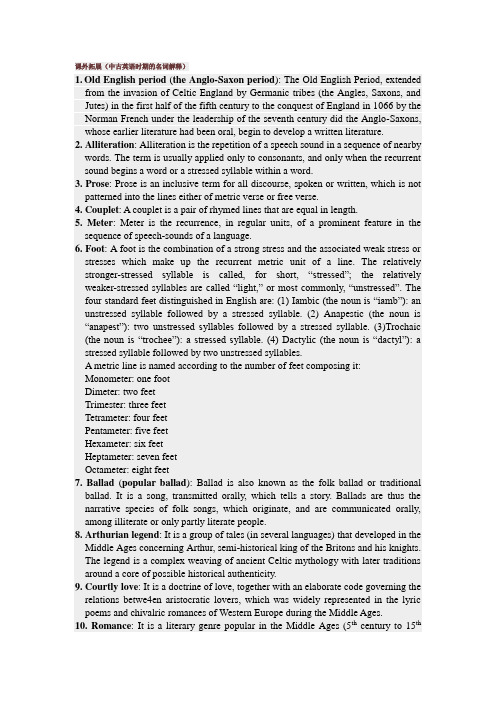
课外拓展(中古英语时期的名词解释)1.Old English period(the Anglo-Saxon period): The Old English Period, extended from the invasion of Celtic England by Germanic tribes (the Angles, Saxons, and Jutes) in the first half of the fifth century to the conquest of England in 1066 by the Norman French under the leadership of the seventh century did the Anglo-Saxons, whose earlier literature had been oral, begin to develop a written literature.2. Alliteration: Alliteration is the repetition of a speech sound in a sequence of nearby words. The term is usually applied only to consonants, and only when the recurrent sound begins a word or a stressed syllable within a word.3. Prose: Prose is an inclusive term for all discourse, spoken or written, which is not patterned into the lines either of metric verse or free verse.4. Couplet: A couplet is a pair of rhymed lines that are equal in length.5. Meter: Meter is the recurrence, in regular units, of a prominent feature in the sequence of speech-sounds of a language.6. Foot: A foot is the combination of a strong stress and the associated weak stress or stresses which make up the recurrent metric unit of a line. The relatively stronger-stressed syllable is called, for short, “stressed”; the relatively weaker-stressed syllables are called “light,” or most commonly, “unstressed”. The four standard feet distinguished in English are: (1) Iambic (the noun is “iamb”): an unstressed syllable followed by a stressed syllable. (2) Anapestic (the noun is “anapest”): two unstressed syllables fo llowed by a stressed syllable. (3)Trochaic (the noun is “trochee”): a stressed syllable. (4) Dactylic (the noun is “dactyl”): a stressed syllable followed by two unstressed syllables.A metric line is named according to the number of feet composing it: Monometer: one footDimeter: two feetTrimester: three feetTetrameter: four feetPentameter: five feetHexameter: six feetHeptameter: seven feetOctameter: eight feet7. Ballad (popular ballad): Ballad is also known as the folk ballad or traditional ballad. It is a song, transmitted orally, which tells a story. Ballads are thus the narrative species of folk songs, which originate, and are communicated orally, among illiterate or only partly literate people.8. Arthurian legend: It is a group of tales (in several languages) that developed in the Middle Ages concerning Arthur, semi-historical king of the Britons and his knights. The legend is a complex weaving of ancient Celtic mythology with later traditions around a core of possible historical authenticity.9. Courtly love: It is a doctrine of love, together with an elaborate code governing the relations betwe4en aristocratic lovers, which was widely represented in the lyric poems and chivalric romances of Western Europe during the Middle Ages.10. Romance: It is a literary genre popular in the Middle Ages (5th century to 15thcentury), dealing, in verse or prose, with legendary, supernatural, or amorous subjects and characters. The name refers to Romance languages and originally denoted any lengthy composition in one of those languages. Later the term was applied to tales specifically concerned with knights, chivalry, and courtly love. Romances were written by court musicians, clerics, scribes, and aristocrats for the entertainment and moral edification of the nobility. Popular subjects for romances included the Macedonian King Alexander the Great, King Arthur Charlemagne. Later prose and verse narratives, particularly those in the 19th-century romantic tradition, are also referred to as romances; set in distant or mythological places and times, like most romances they stress adventure and supernatural elements.。
古英语和中世纪英语词语
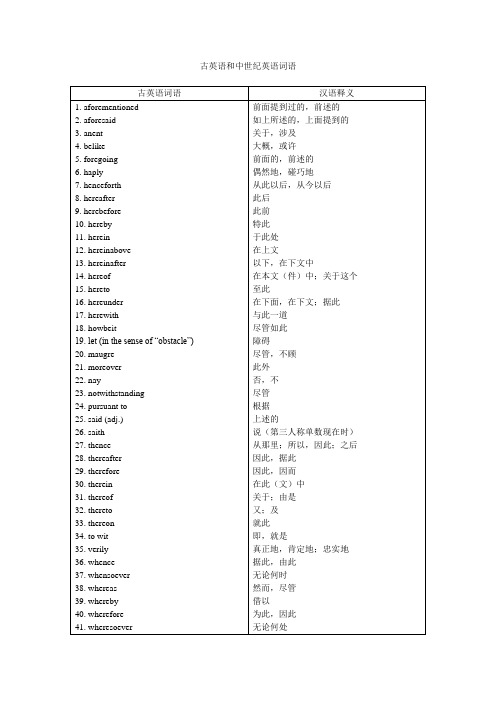
古英语词语
汉语释义
1. aforementioned
2. aforesaid
3. anent
4. belike
5. foregoing
6. haply
7. henceforth
8. hereafter
9. herebefore
10. hereby
11. herein
12. hereinabove
此后
此前
特此
于此处
在上文
以下,在下文中
在本文(件)中;关于这个
至此
在下面,在下文;据此
与此一道
尽管如此
障碍
尽管,不顾
此外
否,不
尽管
根据
上述的
说(第三人称单数现在时)
从那里;所以,因此;之后
因此,据此
因此,因而
在此(文)中
关于;由是
又;及
就此
即,就是
真正地,肯定地;忠实地
据此,由此
无论何时
然而,尽管
借以
24. pursuant to
25. said (adj.)
26. saith
27. thence
28. thereafter
29. therefore
30. therein
31. thereof
32. thereto
33. thereon
34. to wit
35. verily
36. whence
37. whensoever
38. whereas
39. whereby
40. wherefore
41. wheresoever
古英语和中世纪英语词汇
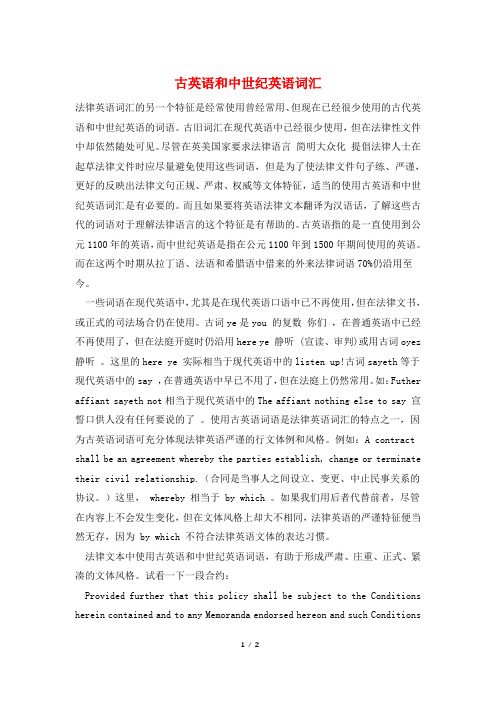
古英语和中世纪英语词汇法律英语词汇的另一个特征是经常使用曾经常用、但现在已经很少使用的古代英语和中世纪英语的词语。
古旧词汇在现代英语中已经很少使用,但在法律性文件中却依然随处可见。
尽管在英美国家要求法律语言简明大众化提倡法律人士在起草法律文件时应尽量避免使用这些词语,但是为了使法律文件句子练、严谨,更好的反映出法律文句正规、严肃、权威等文体特征,适当的使用古英语和中世纪英语词汇是有必要的。
而且如果要将英语法律文本翻译为汉语话,了解这些古代的词语对于理解法律语言的这个特征是有帮助的。
古英语指的是一直使用到公元1100年的英语,而中世纪英语是指在公元1100年到1500年期间使用的英语。
而在这两个时期从拉丁语、法语和希腊语中借来的外来法律词语70%仍沿用至今。
一些词语在现代英语中,尤其是在现代英语口语中已不再使用,但在法律文书,或正式的司法场合仍在使用。
古词ye是you 的复数你们,在普通英语中已经不再使用了,但在法庭开庭时仍沿用here ye 静听 (宣读、审判)或用古词oyez 静听。
这里的here ye 实际相当于现代英语中的listen up!古词sayeth等于现代英语中的say ,在普通英语中早已不用了,但在法庭上仍然常用。
如:Futher affiant sayeth not相当于现代英语中的The affiant nothing else to say 宣誓口供人没有任何要说的了。
使用古英语词语是法律英语词汇的特点之一,因为古英语词语可充分体现法律英语严谨的行文体例和风格。
例如:A contract shall be an agreement whereby the parties establish, change or terminate their civil relationship.(合同是当事人之间设立、变更、中止民事关系的协议。
)这里, whereby 相当于 by which 。
英语发展史及词汇构成.ppt

1.古英语时期
(又称盎格鲁-萨克森时期公元450——1100年)
The history of English language began over 1500 years ago in the north of Europe. About the fifth century A.D., tribes of people known as the Angels, Saxons, and Jutes traveled west from Germany and Denmark across the north sea. They settled in Britain, and by the late of the seventh century, they were speaking an early form of the English.
大量的法语词涌入,也使得英语词汇起了词义变化,
有一些英语固有的词被淘汰掉了,有一些虽然还存在,
但词义范围有所改变,或者带上了特有的文体色彩和 感情色彩。例如,wed在古英语中做 “结婚”解,但 在中古英语时期传入了法语词 “merry”,英语中结 婚这一意义渐渐由“marry”来表示,wed只用在引申 义中了。它的动名词wedding还是一个常用词,但只 限于指“婚礼”。带有不同文体意义英语本族词与法 语并存组成了英语中特有的同意此群格式。
在8世纪末,斯堪的纳维亚人攻占英国。战争持续了 将近200年。在这个时期,很多拉丁语、丹麦语和古 斯堪的纳维亚的单词融入英语。拉丁语给了英语很多
单词。从丹麦语和古斯堪的纳维亚语中,英国人借鉴
过来了皮肤、腿以及各种词格的的代词“他们”、
“他们的”。来自古斯堪的纳维亚语的很多同义词统 一到英语中。例如,愤怒(英语wrath和古斯堪的纳 维亚语anger);生病(英语sick和古斯堪的纳维亚 语ill),都在英语中进行了统一。
- 1、下载文档前请自行甄别文档内容的完整性,平台不提供额外的编辑、内容补充、找答案等附加服务。
- 2、"仅部分预览"的文档,不可在线预览部分如存在完整性等问题,可反馈申请退款(可完整预览的文档不适用该条件!)。
- 3、如文档侵犯您的权益,请联系客服反馈,我们会尽快为您处理(人工客服工作时间:9:00-18:30)。
古英语和中世纪英语词汇
法律英语词汇的另一个特征是经常使用曾经常用、但现在已经很少使用的古代英语和中世纪英语的词语。
古旧词汇在现代英语中已经很少使用,但在法律性文件中却依然随处可见。
尽管在英美国家要求法律语言“简明大众化”提倡法律人士在起草法律文件时应尽量避免使用这些词语,但是为了使法律文件句子练、严谨,更好的反映出法律文句正规、严肃、权威等文体特征,适当的使用古英语和中世纪英语词汇是有必要的。
而且如果要将英语法律文本翻译为汉语话,了解这些古代的词语对于理解法律语言的这个特征是有帮助的。
古英语指的是一直使用到公元1100年的英语,而中世纪英语是指在公元1100年到1500年期间使用的英语。
而在这两个时期从拉丁语、法语和希腊语中借来的外来法律词语70%仍沿用至今。
一些词语在现代英语中,尤其是在现代英语口语中已不再使用,但在法律文书,或正式的司法场合仍在使用。
古词ye 是you 的复数“你们”,在普通英语中已经不再使用了,但在法庭开庭时仍沿用here ye “静听”(宣读、审判)或用古词oyez “静听”。
这里的here ye 实际相当于现代英语中的listen up!古词sayeth等于现代英语中的say ,在普通英语
中早已不用了,但在法庭上仍然常用。
如:Futher affiant sayeth not相当于现代英语中的The affiant nothing else to say “宣誓口供人没有任何要说的了”。
使用古英语词语是法律英语词汇的特点之一,因为古英语词语可充分体现法律英语严谨的行文体例和风格。
例如:A contract shall be an agreement whereby the parties establish, change or terminate their civil relationship.(合同是当事人之间设立、变更、中止民事关系的协议。
)这里,“whereby”相当于“by which”。
如果我们用后者代替前者,尽管在内容上不会发生变化,但在文体风格上却大不相同,法律英语的严谨特征便当然无存,因为“by which”不符合法律英语文体的表达习惯。
法律文本中使用古英语和中世纪英语词语,有助于形成严肃、庄重、正式、紧凑的文体风格。
试看一下一段合约:Provided further that this policy shall be subject to the Conditions herein contained and to any Memoranda endorsed hereon and such Conditions and part of the Policy and the observance and performance by the Insured of the times and terms therein contained so far as they relate to anything to be done by the Insured are of the essence of this contract and shall
be conditions precedent to any liability on the part of the Insured under this Policy.
上例合约条款选自一份现代的保险合同,但其中herein, hereon ,such全是普通英文中废弃的典型的古旧副词,而其他旧式用法还有provided that ,subject to 等。
